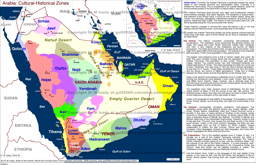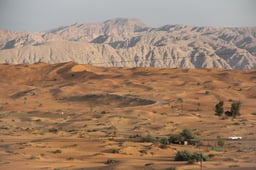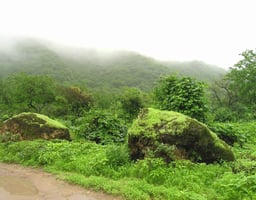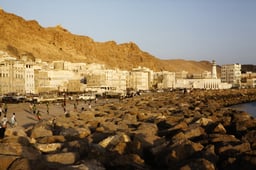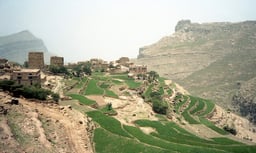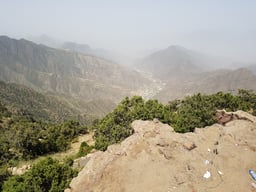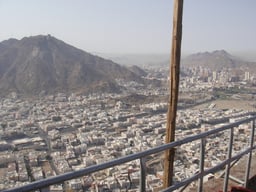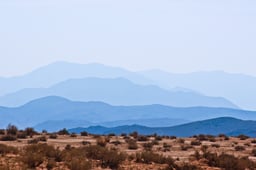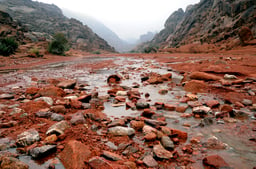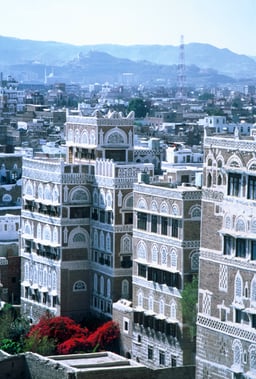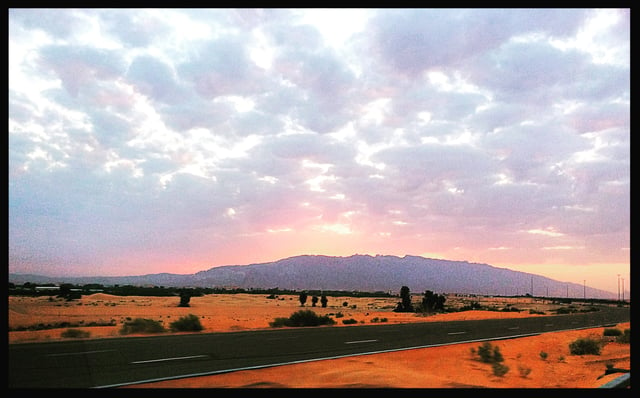Arabian Peninsula
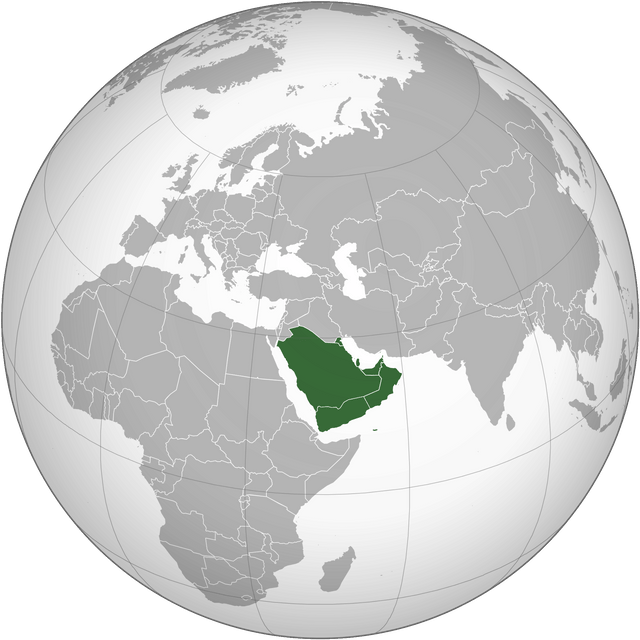
Arabian Peninsula

| Area | 3.2 million km2(1.25 million mi²) |
|---|---|
| Population | 77,983,936 |
| Demonym | Arabian |
| Countries | Saudi Arabia Yemen Oman United Arab Emirates Kuwait Qatar Bahrain |
The Arabian Peninsula, or simply Arabia[1] (/əˈreɪbiə/; Arabic: شِبْهُ الْجَزِيرَةِ الْعَرَبِيَّة shibhu l-jazīrati l-ʿarabiyyah, 'Arabian island' or جَزِيرَةُ الْعَرَب jazīratu l-ʿarab, 'Island of the Arabs'),[2] is a peninsula of Western Asia situated northeast of Africa on the Arabian plate. From a geographical perspective, it is considered a subcontinent of Asia.[3]
It is the largest peninsula in the world, at 3,237,500 km2 (1,250,000 sq mi).[4][5][6][7][8] The peninsula consists of the countries Yemen, Oman, Qatar, Bahrain, Kuwait, Saudi Arabia and the United Arab Emirates.[9] The peninsula formed as a result of the rifting of the Red Sea between 56 and 23 million years ago, and is bordered by the Red Sea to the west and southwest, the Persian Gulf to the northeast, the Levant to the north and the Indian Ocean to the southeast. The peninsula plays a critical geopolitical role in the Arab world due to its vast reserves of oil and natural gas.
Before the modern era, it was divided into four distinct regions: Red Sea Coast (Tihamah), Central Plateau (Al-Yamama), Indian Ocean Coast (Hadhramaut) and Persian Gulf Coast (Al-Bahrain). Hejaz and Najd make up most of Saudi Arabia. Southern Arabia consists of Yemen and some parts of Saudi Arabia (Najran, Jizan, Asir) and Oman (Dhofar). Eastern Arabia consists of the entire coastal strip of the Persian Gulf.
| Area | 3.2 million km2(1.25 million mi²) |
|---|---|
| Population | 77,983,936 |
| Demonym | Arabian |
| Countries | Saudi Arabia Yemen Oman United Arab Emirates Kuwait Qatar Bahrain |
Geography
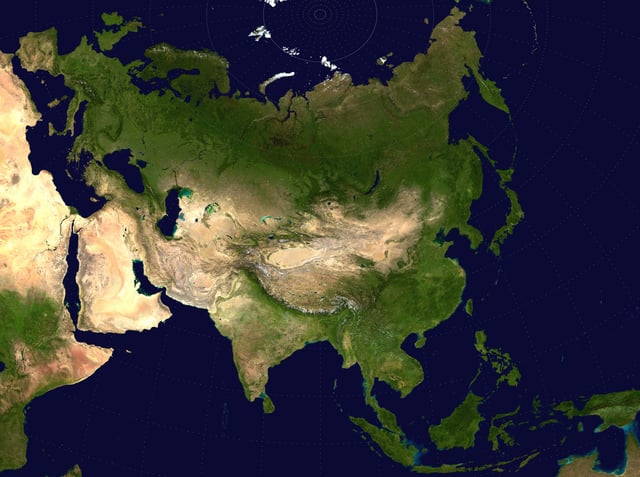
Africa, Arabian subcontinent (Asia), and Eurasia
The Arabian Peninsula is located in the continent of Asia and bounded by (clockwise) the Persian Gulf on the northeast, the Strait of Hormuz and the Gulf of Oman on the east, the Arabian Sea on the southeast and south, the Gulf of Aden on the south, the Bab-el-Mandeb Strait on the southwest and the Red Sea, which is located on the southwest and west.[10] The northern portion of the peninsula merges with the Syrian Desert with no clear borderline, although the northern boundary of the peninsula is generally considered to be the northern borders of Saudi Arabia and Kuwait.[10]
The most prominent feature of the peninsula is desert, but in the southwest, there are mountain ranges, which receive greater rainfall than the rest of the peninsula. Harrat ash Shaam is a large volcanic field that extends from northwestern Arabia into Jordan and southern Syria.[11]
Political boundaries

The Peninsula

Arabian Peninsula and surrounding countries
The peninsula's constituent countries are (clockwise north to south) Kuwait, Bahrain, Qatar, and the United Arab Emirates (UAE) on the east, Oman on the southeast, Yemen on the south and Saudi Arabia at the center.[10] The island nation of Bahrain lies off the east coast of the peninsula.
Six countries (Saudi Arabia, Kuwait, Bahrain, Qatar, United Arab Emirates and Oman) form the Gulf Cooperation Council (GCC).[12]
The Kingdom of Saudi Arabia covers the greater part of the peninsula. The majority of the population of the peninsula live in Saudi Arabia and Yemen. The peninsula contains the world's largest reserves of oil. Saudi Arabia and the UAE are economically the wealthiest in the region. Qatar, a small peninsula in the Persian Gulf on the larger peninsula, is home to the Arabic-language television station Al Jazeera and its English-language subsidiary Al Jazeera English. Kuwait, on the border with Iraq, is an important country strategically, forming one of the main staging grounds for coalition forces mounting the invasion of Iraq in 2003.
Population
Though historically lightly populated, political Arabia is noted for a high population growth rate – as the result of both very strong inflows of migrant labor as well as sustained high birth rates. The population tends to be relatively young and heavily skewed gender ratio dominated by males. In many states, the number of South Asians exceeds that of the local citizenry. The four smallest states (by area), which have their entire coastlines on the Persian Gulf, exhibit the world's most extreme population growth, roughly tripling every 20 years. In 2014, the estimated population of the Arabian Peninsula was 77,983,936 (including expatriates).[16] The Arabian Peninsula is known for having one of the most uneven adult sex ratios in the world with females in some regions (especially the east) constituting only a quarter of vicenarians and tricenarians.[17]
21-chromosome

Distribution of J1 haplogroup
Haplogroup J is the most abundant component in the Arabian peninsula, embracing more than 50% of its Y-chromosomes.
Its two main subclades (J1-M267 and J2-M172), show opposite latitudinal gradients in the Middle East.
J1-M267 is more abundant in the southern areas, reaching a frequency around 73% in Yemen, whereas J2-M172 is more common in the Levant.
J (L222.2) Accounts for the majority of (L147.1) in Saudi Arabia. It seems to be an exclusively Adnani marker.[22][26][27]
Haplogroup J 54.8%
Haplogroup E 17.5% R 11.6%
Haplogroup T-M184 5.1%
Landscape
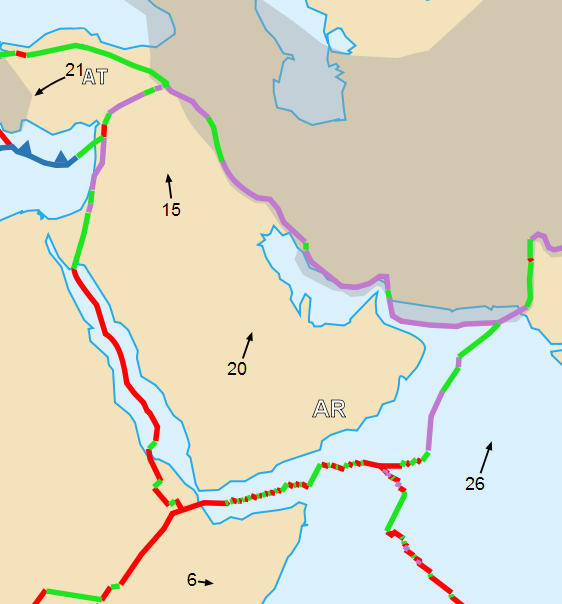
AR-Arabian Plate, velocities with respect to Africa in millimeters per year

Ras al-Jinz in southeastern Arabia (Oman), also known as the 'Turtle Beach'
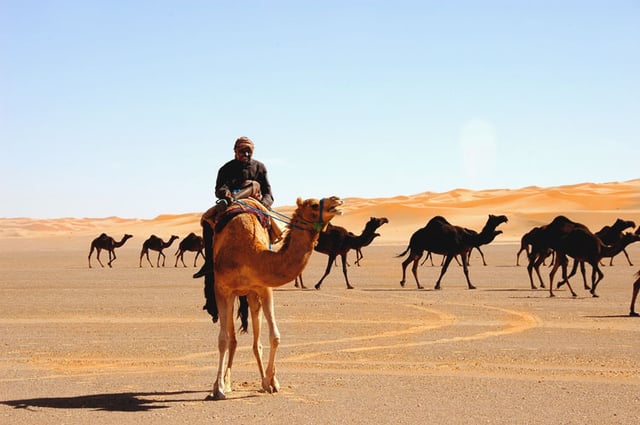
A caravan crossing Ad-Dahna Desert in central Saudi Arabia
Geologically, this region is perhaps more appropriately called the Arabian subcontinent because it lies on a tectonic plate of its own, the Arabian Plate, which has been moving incrementally away from the rest of Africa (forming the Red Sea) and north, toward Asia, into the Eurasian Plate (forming the Zagros Mountains). The rocks exposed vary systematically across Arabia, with the oldest rocks exposed in the Arabian-Nubian Shield near the Red Sea, overlain by earlier sediments that become younger towards the Persian Gulf. Perhaps the best-preserved ophiolite on Earth, the Semail Ophiolite, lies exposed in the mountains of the UAE and northern Oman.
The peninsula consists of:
A central plateau, the Najd, with fertile valleys and pastures used for the grazing of sheep and other livestock
A range of deserts: the Nefud in the north,[28] which is stony; the Rub' al Khali or Great Arabian Desert in the south, with sand estimated to extend 600 ft (180 m) below the surface; between them, the Dahna
Stretches of dry or marshy coastland with coral reefs on the Red Sea side (Tihamah)
Oases and marshy coast-land in Eastern Arabia on the Persian Gulf side, the most important of which are those of Al Ain (in the UAE, on the border with Oman) and Al-Hasa (in Saudi Arabia), according to one author[31]
Arabia has few lakes or permanent rivers. Most areas are drained by ephemeral watercourses called wadis, which are dry except during the rainy season. Plentiful ancient aquifers exist beneath much of the peninsula, however, and where this water surfaces, oases form (e.g. Al-Hasa and Qatif, two of the world's largest oases) and permit agriculture, especially palm trees, which allowed the peninsula to produce more dates than any other region in the world. In general, the climate is extremely hot and arid, although there are exceptions. Higher elevations are made temperate by their altitude, and the Arabian Sea coastline can receive surprisingly cool, humid breezes in summer due to cold upwelling offshore. The peninsula has no thick forests. Desert-adapted wildlife is present throughout the region.
According to NASA's Gravity Recovery and Climate Experiment (GRACE) satellite data (2003–2013) analysed in a University of California, Irvine (UCI)-led study published in Water Resources Research on 16 June 2015, the most over-stressed aquifer system in the world is the Arabian Aquifer System, upon which more than 60 million people depend for water.[32] Twenty-one of the thirty seven largest aquifers "have exceeded sustainability tipping points and are being depleted" and thirteen of them are "considered significantly distressed."[32]
A plateau more than 2,500 feet (760 m) high extends across much of the Arabian Peninsula. The plateau slopes eastwards from the massive, rifted escarpment along the coast of the Red Sea, to the shallow waters of the Persian Gulf. The interior is characterised by cuestas and valleys, drained by a system of wadis. A crescent of sand and gravel deserts lies to the east.
Mountains
There are mountains at the eastern, southern and northwestern borders of the peninsula. Broadly, the ranges can be grouped as follows:
Northeast: The Hajar range, shared by the UAE and northern Oman[31]
Southeast: The Dhofar Mountains of southern Oman,[31] contiguous with the eastern Yemeni Hadhramaut[34][35]
West: Bordering the eastern coast of the Red Sea are the Sarawat,[29] which can be seen to include the Haraz Mountains of eastern Yemen,[30] and the 'Asir[36] and Hijaz Mountains of western Saudi Arabia,[37][38] the latter including the Midian in northwestern Saudi Arabia[34]
Northwest: Aside from the Sarawat, the northern portion of Saudi Arabia hosts the Shammar Mountains, which include the Aja and Salma subranges[31]
Central: The Najd hosts the Tuwaiq Escarpment[34] or Tuwair range[31]
From the Hejaz southwards, the mountains show a steady increase in altitude westward as they get nearer to Yemen, and the highest peaks and ranges are all located in Yemen. The highest, Jabal An-Nabi Shu'ayb of the Haraz subrange of the Sarawat range, is about 3,666 m (2.278 mi) high.[29][30] By comparison, the Tuwayr, Shammar and Dhofar generally do not exceed 1,000 m (0.62 mi) in height.[31]
Land and sea
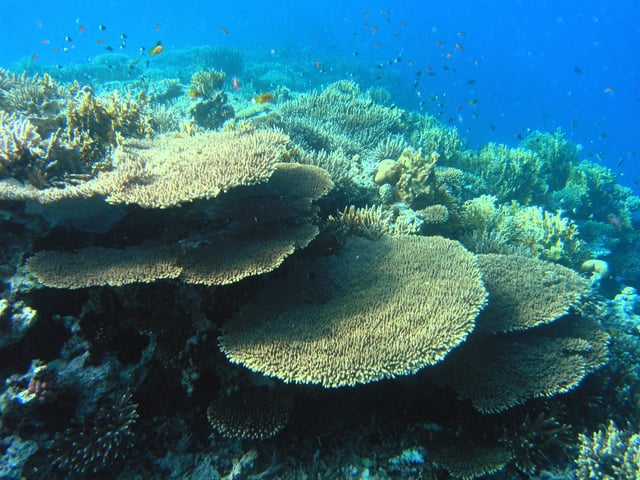
Red Sea coral reefs
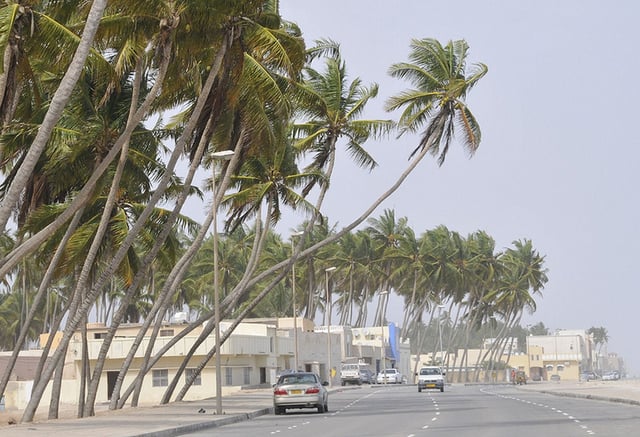
Coconut palms line corniches of Al-Hafa, Oman
Most of the Arabian Peninsula is unsuited to agriculture, making irrigation and land reclamation projects essential. The narrow coastal plain and isolated oases, amounting to less than 1% of the land area, are used to cultivate grains, coffee and tropical fruits. Goat, sheep, and camel husbandry is widespread elsewhere throughout the rest of the Peninsula. Some areas have a summer humid tropical monsoon climate, in particular the Dhofar and Al Mahrah areas of Oman and Yemen. These areas allow for large scale coconut plantations. Much of Yemen has a tropical monsoon rain influenced mountain climate. The plains usually have either a tropical or subtropical arid desert climate or arid steppe climate. The sea surrounding the Arabian Peninsula is generally tropical sea with a very rich tropical sea life and some of the world's largest, undestroyed and most pristine coral reefs. In addition, the organisms living in symbiosis with the Red Sea coral, the protozoa and zooxanthellae, have a unique hot weather adaptation to sudden rise (and fall) in sea water temperature. Hence, these coral reefs are not affected by coral bleaching caused by rise in temperature as elsewhere in the indopacific coral sea. The reefs are also unaffected by mass tourism and diving or other large scale human interference. However, some reefs were destroyed in the Persian Gulf, mostly caused by phosphate water pollution and resultant increase in algae growth as well as oil pollution from ships and pipeline leakage.
The fertile soils of Yemen have encouraged settlement of almost all of the land from sea level up to the mountains at 10,000 feet (3,000 m). In the higher reaches, elaborate terraces have been constructed to facilitate grain, fruit, coffee, ginger and khat cultivation. The Arabian peninsula is known for its rich oil, i.e. petroleum production due to its geographical location.
Etymology
Arabia Petraea: for the area that is today southern modern Syria, Jordan, the Sinai Peninsula and northwestern Saudi Arabia. It was the only one that became a province, with Petra as its capital.
Arabia Deserta ("Desert Arabia"): signified the desert interior of the Arabian peninsula. As a name for the region, it remained popular into the 19th and 20th centuries, and was used in Charles M. Doughty's Travels in Arabia Deserta (1888).
Arabia Felix ("Fortunate Arabia"): was used by geographers to describe what is now Yemen, which enjoys more rainfall, is much greener than the rest of the peninsula and has long enjoyed much more productive fields.
The Arab inhabitants used a north-south division of Arabia: Al Sham-Al Yaman, or Arabia Deserta-Arabia Felix. Arabia Felix had originally been used for the whole peninsula, and at other times only for the southern region. Because its use became limited to the south, the whole peninsula was simply called Arabia. Arabia Deserta was the entire desert region extending north from Arabia Felix to Palmyra and the Euphrates, including all the area between Pelusium on the Nile and Babylon. This area was also called Arabia and not sharply distinguished from the peninsula.[40]
The Arabs and the Ottoman Empire considered the west of the Arabian Peninsula region where the Arabs lived 'the land of the Arabs' – Bilad al-Arab (Arabia), and its major divisions were the bilad al-Sham (Syria), bilad al-Yaman (the Land of the southern Peninsula), and Bilad al-Iraq and modern-day Kuwait (the Land of the River Banks).[41] The Ottomans used the term Arabistan in a broad sense for the subcontinent itself starting from Cilicia, where the Euphrates river makes its descent into Syria, through Palestine, and on through the remainder of the Sinai and Arabian peninsulas.[42]
History

Ancient coins from Failaka Island, Kuwait
The history of the Arabian Peninsula goes back to the beginnings of human habitation in Arabia up to 130,000 years ago.[45] However, a homo sapien fossilized finger bone was found at Al Wusta in the Nefud Desert, which indicates that the first human migration out of Africa to Arabia might date back to approximately 90,000 years ago.[46] Nevertheless, the stone tools from the Middle Paleolithic age along with fossils of other animals discovered at Ti's al Ghadah, in northwestern Saudi Arabia, might imply that hominids migrated through a "Green Arabia" between 300,000 and 500,000 years ago.[47] Acheulean tools found in Saffaqah, Riyadh Region reveal that hominins lived in the Arabian Peninsula as recently as 188,000 years ago.[48]
Pre-Islamic Arabia

Sabaean inscription addressed to the god Almaqah, mentioning five Ancient Yemeni gods, two reigning sovereigns and two governors, 7th century BC
There is evidence that human habitation in the Arabian Peninsula dates back to about 106,000 to 130,000 years ago.[49] The harsh climate historically prevented much settlement in the pre-Islamic Arabian peninsula, apart from a small number of urban trading settlements, such as Mecca and Medina, located in the Hejaz in the west of the peninsula.[50]
Archaeology has revealed the existence of many civilizations in pre-Islamic Arabia (such as the Thamud), especially in South Arabia.[51][52] South Arabian civilizations include the Sheba, the Himyarite Kingdom, the Kingdom of Awsan, the Kingdom of Ma'īn and the Sabaean Kingdom. Central Arabia was the location of the Kingdom of Kindah in the 4th, 5th and early 6th centuries AD. Eastern Arabia was home to the Dilmun civilization. The earliest known events in Arabian history are migrations from the peninsula into neighbouring areas.[53]
Rise of Islam

Age of the Caliphs Expansion under Muhammad, 622–632/A.H. 1–11 Expansion during Rashidun Caliphate, 632–661/A.H. 11–40 Expansion during the Umayyad Caliphate, 661–750/A.H. 40–129

Approximate locations of some of the important tribes and Empire of the Arabian Peninsula around the time that Muhammad started preaching Islam (approximately 600 CE / 20 BH)
The seventh century saw the rise of Islam as the peninsula's dominant religion. The Islamic prophet Muhammad was born in Mecca in about 570 and first began preaching in the city in 610, but migrated to Medina in 622. From there he and his companions united the tribes of Arabia under the banner of Islam and created a single Arab Muslim religious polity in the Arabian peninsula.
Muhammad established a new unified polity in the Arabian peninsula which under the subsequent Rashidun and Umayyad Caliphates saw a century of rapid expansion of Arab power well beyond the Arabian peninsula in the form of a vast Muslim Arab Empire with an area of influence that stretched from the northwest Indian subcontinent, across Central Asia, the Middle East, North Africa, southern Italy, and the Iberian Peninsula, to the Pyrenees.
Muhammad began preaching Islam at Mecca before migrating to Medina, from where he united the tribes of Arabia into a singular Arab Muslim religious polity. With Muhammad's death in 632 AD, disagreement broke out over who would succeed him as leader of the Muslim community. Umar ibn al-Khattab, a prominent companion of Muhammad, nominated Abu Bakr, who was Muhammad's intimate friend and collaborator. Others added their support and Abu Bakr was made the first caliph. This choice was disputed by some of Muhammad's companions, who held that Ali ibn Abi Talib, his cousin and son-in-law, had been designated his successor. Abu Bakr's immediate task was to avenge a recent defeat by Byzantine (or Eastern Roman Empire) forces, although he first had to put down a rebellion by Arab tribes in an episode known as the Ridda wars, or "Wars of Apostasy".[58]
Following Muhammad's death in 632, Abu Bakr became leader of the Muslims as the first Caliph. After putting down a rebellion by the Arab tribes (known as the Ridda wars, or "Wars of Apostasy"), Abu Bakr attacked the Byzantine Empire. On his death in 634, he was succeeded by Umar as caliph, followed by Uthman ibn al-Affan and Ali ibn Abi Talib. The period of these first four caliphs is known as al-khulafā' ar-rāshidūn: the Rashidun or "rightly guided" Caliphate. Under the Rashidun Caliphs, and, from 661, their Umayyad successors, the Arabs rapidly expanded the territory under Muslim control outside of Arabia. In a matter of decades Muslim armies decisively defeated the Byzantine army and destroyed the Persian Empire, conquering huge swathes of territory from the Iberian peninsula to India. The political focus of the Muslim world then shifted to the newly conquered territories.[59][60]
Nevertheless, Mecca and Medina remained the spiritually most important places in the Muslim world. The Qur'an requires every able-bodied Muslim who can afford it, as one of the five pillars of Islam, to make a pilgrimage, or Hajj, to Mecca during the Islamic month of Dhu al-Hijjah at least once in his or her lifetime.[61] The Masjid al-Haram (the Grand Mosque) in Mecca is the location of the Kaaba, Islam's holiest site, and the Masjid al-Nabawi (the Prophet's Mosque) in Medina is the location of Muhammad tomb; as a result, from the 7th century, Mecca and Medina became the pilgrimage destinations for large numbers of Muslims from across the Islamic world.[62]
Middle Ages
However, from the 10th century (and, in fact, until the 20th century) the Hashemite Sharifs of Mecca maintained a state in the most developed part of the region, the Hejaz. Their domain originally comprised only the holy cities of Mecca and Medina but in the 13th century it was extended to include the rest of the Hejaz. Although, the Sharifs exercised at most times independent authority in the Hejaz, they were usually subject to the suzerainty of one of the major Islamic empires of the time. In the Middle Ages, these included the Abbasids of Baghdad, and the Fatimids, Ayyubids and Mamluks of Egypt.[63]
Modern history

Ottoman territories acquired between 1481 and 1683 (See: list of territories)
The provincial Ottoman Army for Arabia (Arabistan Ordusu) was headquartered in Syria, which included Palestine, the Transjordan region in addition to Lebanon (Mount Lebanon was, however, a semi-autonomous mutasarrifate). It was put in charge of Syria, Cilicia, Iraq, and the remainder of the Arabian Peninsula.[64][65] The Ottomans never had any control over central Arabia, also known as the Najd region.
The Damascus Protocol of 1914 provides an illustration of the regional relationships. Arabs living in one of the existing districts of the Arabian peninsula, the Emirate of Hejaz, asked for a British guarantee of independence. Their proposal included all Arab lands south of a line roughly corresponding to the northern frontiers of present-day Syria and Iraq. They envisioned a new Arab state, or confederation of states, adjoining the southern Arabian Peninsula. It would have comprised Cilicia – İskenderun and Mersin, Iraq with Kuwait, Syria, Mount Lebanon Mutasarrifate, Jordan, and Palestine.[66]
In the modern era, the term bilad al-Yaman came to refer specifically to the southwestern parts of the peninsula. Arab geographers started to refer to the whole peninsula as 'jazirat al-Arab', or the peninsula of the Arabs.[67]
Late Ottoman rule and the Hejaz Railway
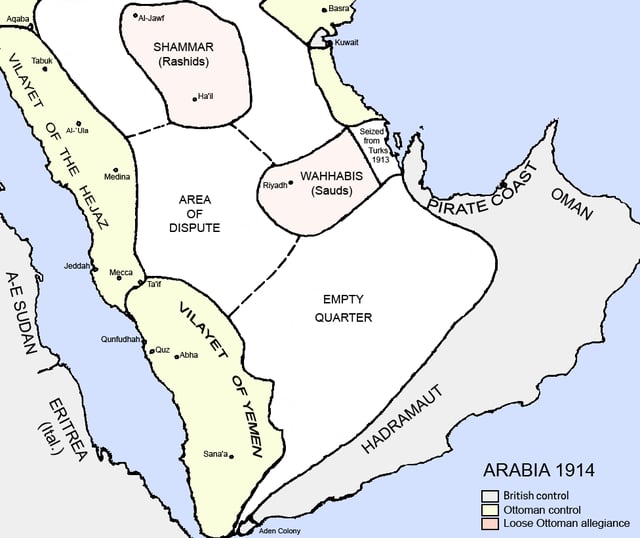
The peninsula in 1914
In the beginning of the 20th century, the Ottomans embarked on an ambitious project: the construction of a railway connecting Istanbul, the capital of the Ottoman Empire and the seat of the Islamic Caliphate, and Hejaz with its holiest shrines of Islam which are the yearly pilgrimage destination of the Hajj. Another important goal was to improve the economic and political integration of the distant Arabian provinces into the Ottoman state, and to facilitate the transportation of military troops in case of need.
The Hejaz Railway was a narrow gauge railway (1,050 km (650 mi)) that ran from Damascus to Medina, through the Hejaz region of Arabia. It was originally planned to reach the holy city of Mecca, but due to the interruption of the construction works caused by the outbreak of World War I, it eventually only reached Medina. It was a part of the Ottoman railway network and was built in order to extend the previously existing line between Istanbul and Damascus (which began from the Haydarpaşa Terminal).
The railway was started in 1900 at the behest of the Ottoman Sultan Abdul Hamid II and was built largely by the Turks, with German advice and support. A public subscription was opened throughout the Islamic world to fund the construction. The railway was to be a waqf, an inalienable religious endowment or charitable trust.[68]
The Arab Revolt and the foundation of Saudi Arabia
The major developments of the early 20th century were the Arab Revolt during World War I and the subsequent collapse and partitioning of the Ottoman Empire. The Arab Revolt (1916–1918) was initiated by the Sherif Hussein ibn Ali with the aim of securing independence from the ruling Ottoman Empire and creating a single unified Arab state spanning from Aleppo in Syria to Aden in Yemen. During World War I, the Sharif Hussein entered into an alliance with the United Kingdom and France against the Ottomans in June 1916.
These events were followed by the foundation of Saudi Arabia under King Abdulaziz Ibn Saud. In 1902, Ibn Saud had captured Riyadh. Continuing his conquests, Abdulaziz subdued Al-Hasa, Jabal Shammar, Hejaz between 1913 and 1926 founded the modern state of Saudi Arabia. The Saudis absorbed the Emirate of Asir, with their expansion only ending in 1934 after a war with Yemen. Two Saudi states were formed and controlled much of Arabia before Ibn Saud was even born. Ibn Saud, however, established the third Saudi state.
Oil reserves
The second major development has been the discovery of vast reserves of oil in the 1930s. Its production brought great wealth to all countries of the region, with the exception of Yemen.
Civil war in Yemen
The North Yemen Civil War was fought in North Yemen between royalists of the Mutawakkilite Kingdom of Yemen and factions of the Yemen Arab Republic from 1962 to 1970. The war began with a coup d'état carried out by the republican leader, Abdullah as-Sallal, which dethroned the newly crowned Muhammad al-Badr and declared Yemen a republic under his presidency. The Imam escaped to the Saudi Arabian border and rallied popular support.
The royalist side received support from Saudi Arabia, while the republicans were supported by Egypt and the Soviet Union. Both foreign irregular and conventional forces were also involved. The Egyptian President, Gamal Abdel Nasser, supported the republicans with as many as 70,000 troops. Despite several military moves and peace conferences, the war sank into a stalemate. Egypt's commitment to the war is considered to have been detrimental to its performance in the Six-Day War of June 1967, after which Nasser found it increasingly difficult to maintain his army's involvement and began to pull his forces out of Yemen.
Gulf War
In 1990, Iraq invaded Kuwait.[70] The invasion of Kuwait by Iraqi forces led to the 1990–91 Gulf War. Egypt, Qatar, Syria and Saudi Arabia joined a multinational coalition that opposed Iraq. Displays of support for Iraq by Jordan and Palestine resulted in strained relations between many of the Arab states. After the war, a so-called "Damascus Declaration" formalized an alliance for future joint Arab defensive actions between Egypt, Syria, and the GCC member states.[71]
Yemen Arab Spring
The Arab Spring reached Yemen in January 2011.[72]
People of Yemen took to the street demonstrating against three decades of rule by President Ali Abdullah Saleh.[73]
After numerous attempt Saleh accepted the Gulf Cooperation Council mediation. He eventually handed power to Vice President Hadi. He was sworn in as President of Yemen on Feb 25,2012. He launched a national dialogue to address new constitution, political and social issues.
Transport and industry
The extraction and refining of oil and gas are the major industrial activities in the Arabian Peninsula. The region also has an active construction sector, with many cities reflecting the wealth generated by the oil industry. The service sector is dominated by financial and technical institutions, which, like the construction sector, mainly serve the oil industry. Traditional handicrafts such as carpet-weaving are found in rural areas of Arabia.
